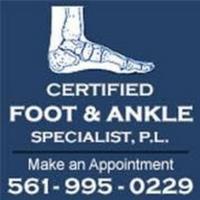What Causes High Arches and How High Arch Foot Problems Occur

Sometimes, people have high-arched feet based on genetics. In other situations, an underlying condition creates high arches on the feet. Those who have high arches often experience high foot arch problems, which may create foot pain or damage to the foot. Thankfully, there are many treatments for foot problems, including surgery, physical therapy, splints, and orthotics.
What Are High-Arched Feet?
You’ll find the arch of the foot between the ball and the heel of the foot. Sometimes people have higher arches than others. People with high arch feet can experience issues, ranging from minor arch pain to permanent skeletal problems.
Are you curious whether you have high foot arches? There’s an easy way to find out. Moisten the feet and stand on a piece of paper or a patch of concrete. When you move the foot, check the imprint. Those with high foot arches will see the front of the foot and heel with no impression in the middle.
You can also learn whether you have high arches by speaking with a podiatrist. Several tests can be done to see how severe the problem is.
What Are the Most Common High Arch Foot Problems?
There are a variety of conditions associated with high-arched feet. Below is a short list of some of the most common, as well as basic information for each:
- Ankle instability: A high arch foot can decrease ankle stability and increase the chance of issues like ankle sprains.
- Claw toes: People who have claw toes have toes that curl downward and dig into the soles of the shoes. Claw toes also may negatively impact the way you walk.
- Hammertoes: Hammertoes happen when the second, third, or fourth toes bend at the middle joint. This creates an appearance like a hammer. This causes arch pain and can require surgery.
- Metatarsal fractures: Since high arches can create stress over and over, metatarsal fractures may occur. This refers to small fractures in the bones of the feet.
- Metatarsalgia: This is a condition where there is inflammation in the ball of the foot. Those with metatarsalgia can experience pain when walking or standing for long periods.
- Plantar fasciitis: This issue affects the plantar fascia, which connects the heel to the toes. Plantar fasciitis means that this ligament is inflamed. Pain is often worst when waking in the morning but improves after walking.
What Can Cause High Arch Feet?
Some people are born with high arches, so genetics play a part. However, many other conditions may cause high arches, including:
- Charcot-Marie-Tooth disease (CMT)
- Cerebral palsy
- Muscular dystrophy
- Polio
- Spina bifida
- Spinal cord injuries
- Spinal tumors
- Stroke
Short or long-term pain may be associated with high arches. In many cases, if the high arches are related to a neurological condition, the pain will worsen as time goes on. High arches from genetics typically stay at the same level.
Common Symptoms of High Arch Foot Problems
For those that have high arches, there are many symptoms you might notice that could lead to issues down the road. A few of these include:
- Toes that are bent while standing
- Foot and ankle pain when playing sports, standing, or walking
- Difficulty finding well-fitting shoes
- A heel with an inward tilt
- Corns or calluses on the ball and heel of the foot
How High Arches Are Diagnosed
The first thing that occurs when you see a podiatrist for high arches is giving a family history. Your feet will also examine your foot and look for things like claw toes, hammertoes, and calluses. The foot is tested for muscular strength, and you will have your coordination and walking pattern observed.
In some cases, the entire leg may need to be examined. You may also see the podiatrist look at your shoes to check the wear pattern. X-rays might be used to assess the condition further. Some patients will be sent to a neurologist to have a neurological evaluation.
What Nonsurgical Treatment Can Relieve Pain and Increase Stability:
There are several options for nonsurgical treatment for many people with high arch problems. The medical professional you visit may recommend one or more of the options below:
- Bracing – Your physician will recommend the use of a brace to keep the foot and ankle stable. This can also be used for those experiencing foot drop.
- Custom orthotic devices – These devices are placed in the shoe. They are made to help create better cushioning and support for the feet.
- Shoe modifications – Shoes with high tops can support the ankle while wider heels can increase stability.
When Should Surgery Be Done for High Arch Foot Problems?
If less invasive solutions do not increase stability and relieve pain, surgery may be the best option. It can help with all these issues while making the foot stronger. There are several types of surgeries for high arches. The right one for you will depend on your specific cases.
Final Thoughts
High arches on the feet can create chronic or short-term pain. If your arches are negatively impacting your quality of life, speak with a podiatrist. Many treatment options may reduce your pain and let you better function in daily life.
Sources: https://certifiedfoot.com/








